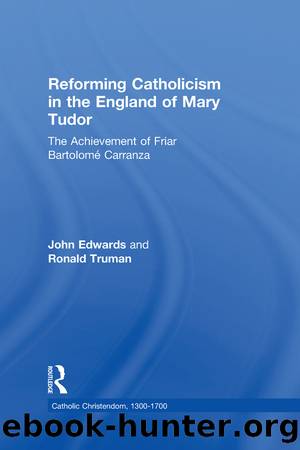Reforming Catholicism in the England of Mary Tudor by Ronald Truman John Edwards

Author:Ronald Truman, John Edwards [Ronald Truman, John Edwards]
Language: eng
Format: epub
ISBN: 9780754652366
Barnesnoble:
Publisher: Taylor & Francis
Published: 2005-03-28T00:00:00+00:00
CHAPTER 7
The Pope, the saints, and the dead:
Uniformity of doctrine in Carranzaâs Catechismo and the printed works of the Marian theologians*
William Wizeman SJ
âJust as men have been corrupted here even more by books than by the spoken word, so they should be recalled to health through the written wordâ.1 In expressing this view in his 1558 letter to his friend, Bartolomé Carranza, Cardinal Reginald Pole was describing part of the strategy that he and his fellow churchmen were employing in the renewal of early modern Catholicism in England during the reign of Mary Tudor. From 1553 to 1558, numerous books were printed that explained Englandâs traditional religion once again, after twenty years of religious tumult. I will attempt to delineate Marian Catholicism as found in these books of doctrine, devotion, apologetics, and sermons regarding two of the most disputed issues of the English Reformation: the Papacy, and what Ronald Hutton has described, I think inaccurately, as the âabiding casualties of the previous Reformationsâ: prayer to the Saints and purgatory. I will also compare these elements of Marian ecclesiology and escha-tology to similar material in other texts, especially the Catechism written by Carranza and intended for England, Comentarios sobre el catechismo christiano, which provided the basis for the Tridentine Catechism and was being translated into English in the summer of 1558.2 Comparing this work of Carranza, who was one of the leading proponents of Catholic Reform, with that of the religious writers whose works were published during Maryâs reign is invaluable in any attempt to delineate the theology, spirituality, and strategies for reform of the Marian Church. Was it, as Geoffrey Dickens wrote, a benighted Church that âfailed to discover the Counter-Reformationâ, or was it a Church that was intimately connected to currents of renewal in what John OâMalley has described as early modern Catholicism in Europe, and which anticipated, as Eamon Duffy has argued, Tridentine reforms?3
Englandâs reconciliation with Rome, after two decades of intense vilification, commences with the publication of numerous declamations regarding the role of the Pope in the Church. Bishops Edmund Bonner of London and Thomas Watson of Lincoln, as well as other writers, presented unequivocal discussions of the Papacy. Two sermons in Bonnerâs frequendy reprinted collection of homilies, sermons by Archdeacon John Harpsfield and Leonard Pollard, and John Standishâs book, The triall of the supremacy, treated the Papacy at length. But most authors, including Carranza, chose to relate discussions of the Popeâs authority to other points of doctrine in their texts. For example, in his Catholyke doctryne, a collection of sermons on the Sacraments, Watson, the most erudite Marian Catholic theologian, referred to the role of the Pope with ardour. And the 1521 sermon by John Fisher, in which he had defended Papal Primacy at length, was reprinted twice during Maryâs reign, the first edition appearing within a month of Englandâs reunion with Rome, on 30 November 1554. As for Carranza, he treated the Papacy while discussing the Sacrament of Order and Christâs resurrection as well as in the more obvious context of the article on the Church in the Aposdesâ Creed.
Download
This site does not store any files on its server. We only index and link to content provided by other sites. Please contact the content providers to delete copyright contents if any and email us, we'll remove relevant links or contents immediately.
Room 212 by Kate Stewart(5016)
The Crown by Robert Lacey(4710)
Endurance: Shackleton's Incredible Voyage by Alfred Lansing(4656)
The Iron Duke by The Iron Duke(4275)
The Rape of Nanking by Iris Chang(4125)
Joan of Arc by Mary Gordon(4000)
Killing England by Bill O'Reilly(3940)
Say Nothing by Patrick Radden Keefe(3892)
I'll Give You the Sun by Jandy Nelson(3344)
Shadow of Night by Deborah Harkness(3279)
Hitler's Monsters by Eric Kurlander(3256)
Mary, Queen of Scots, and the Murder of Lord Darnley by Alison Weir(3138)
Blood and Sand by Alex Von Tunzelmann(3121)
Darkest Hour by Anthony McCarten(3058)
Eleanor & Park by Rainbow Rowell(3042)
Margaret Thatcher: The Autobiography by Thatcher Margaret(3021)
Red Famine: Stalin's War on Ukraine by Anne Applebaum(2859)
Book of Life by Deborah Harkness(2855)
The One Memory of Flora Banks by Emily Barr(2791)
